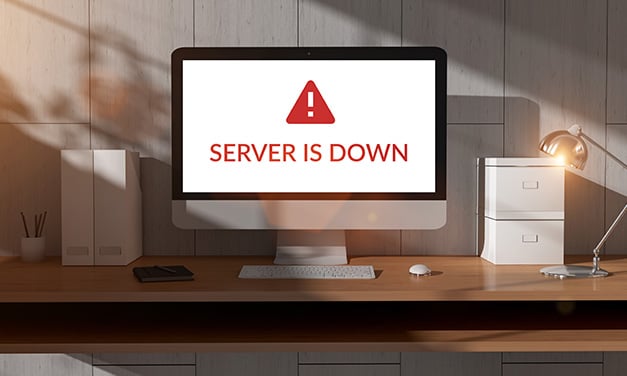Understanding Server Downtime and Its Impact
Server downtime is a major concern for businesses relying on online operations. Whether it is an e-commerce platform, a SaaS application, or a corporate website, any unplanned downtime can lead to revenue loss, reputational damage, and decreased customer trust. Understanding the root causes and implementing effective solutions is crucial for ensuring business continuity and optimal performance.

Common Causes of Server Downtime
Server downtime can be caused by various factors, ranging from hardware failures to cyber threats. Below are some of the most common causes:
A. Hardware Failures
Physical server components such as hard drives, power supplies, and memory modules can fail unexpectedly. These failures may result from:
- Aging hardware components
- Overheating due to poor ventilation
- Power supply issues or sudden surges
- Mechanical failures in hard drives
B. Software Issues and Configuration Errors
Software-related problems can cause servers to crash or become unresponsive. These include:
- Operating system failures
- Bugs in installed applications
- Incorrect server configurations
- Incompatible updates or patches
C. Cybersecurity Threats and Attacks
Hackers and cybercriminals often target servers to disrupt operations or steal sensitive data. Some common threats include:
- Distributed Denial-of-Service (DDoS) attacks
- Malware infections
- Ransomware attacks
- Unauthorized access and data breaches
D. Network Connectivity Issues
Servers rely on network infrastructure to function correctly. Common network-related causes of downtime include:
- Internet Service Provider (ISP) outages
- Router or switch failures
- High latency and packet loss
- DNS configuration issues
E. Human Errors
Even with automation and monitoring tools, human mistakes remain a significant cause of server downtime. These errors can include:
- Accidental deletion of critical files
- Misconfigurations during system updates
- Incorrect changes to server settings
- Failure to follow proper maintenance procedures
F. Power Failures and Natural Disasters
External factors such as power outages, extreme weather conditions, and natural disasters can impact server operations. Without proper backup power solutions, a sudden electricity outage can cause prolonged downtime.
Effective Solutions to Minimize Server Downtime
While server downtime cannot always be eliminated, businesses can take proactive steps to minimize its occurrence and impact.

A. Implement Regular Hardware Maintenance and Upgrades
To prevent hardware failures:
- Conduct routine inspections and stress tests
- Replace aging components before they fail
- Ensure proper ventilation and cooling systems
- Use redundant power supplies and backup generators
B. Keep Software Updated and Secure
Regular updates and patches help maintain server stability. Best practices include:
- Testing updates in a staging environment before deployment
- Installing security patches promptly
- Using reliable software vendors
- Implementing version control for application updates
C. Strengthen Cybersecurity Measures
To protect against cyber threats, businesses should implement:
- Robust firewall and intrusion detection systems
- Regular security audits and vulnerability scans
- Multi-factor authentication (MFA) for access control
- Data encryption and secure backup solutions
D. Ensure Reliable Network Infrastructure
A stable and secure network is crucial for server uptime. Steps to enhance network reliability include:
- Partnering with a reputable ISP with high uptime guarantees
- Using load balancers to distribute traffic
- Configuring redundant network paths
- Monitoring network traffic for anomalies
E. Train Staff and Implement Automation
Reducing human errors requires:
- Comprehensive staff training on best practices
- Clear documentation of server management procedures
- Automation of routine maintenance tasks
- Restricted access to critical server settings
F. Develop a Robust Disaster Recovery Plan
Having a disaster recovery plan can significantly reduce downtime in case of unexpected failures. A solid plan should include:
- Regular data backups stored in multiple locations
- Standby or failover servers ready for activation
- Defined protocols for responding to downtime incidents
- Routine testing and updates to recovery strategies
The Financial and Operational Impact of Server Downtime
Server downtime can have severe consequences on businesses, including:
- Revenue Loss: E-commerce websites and online businesses lose sales during downtime.
- Reputation Damage: Frequent downtimes erode customer trust and brand credibility.
- Operational Disruptions: Employees may be unable to access critical applications, reducing productivity.
- Legal and Compliance Risks: Certain industries have regulations requiring high availability and uptime standards.
Final Thoughts: Proactive Steps to Prevent Downtime
Preventing server downtime requires a multi-faceted approach involving hardware maintenance, software management, cybersecurity enhancements, and staff training. By investing in reliable infrastructure, implementing robust security measures, and preparing for emergencies, businesses can minimize the risks associated with downtime and ensure seamless operations.













